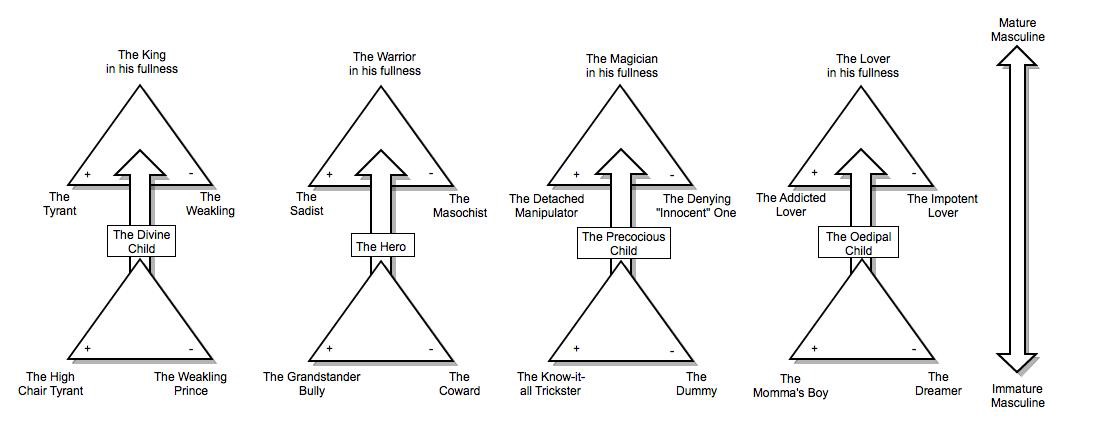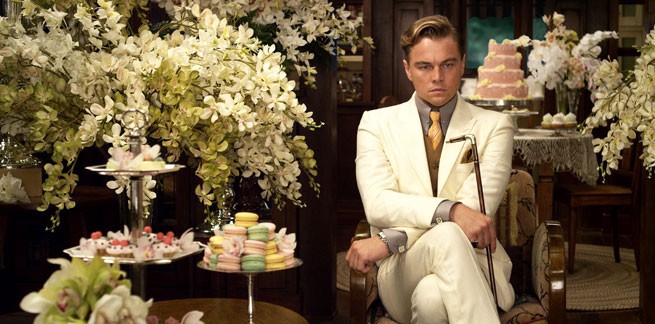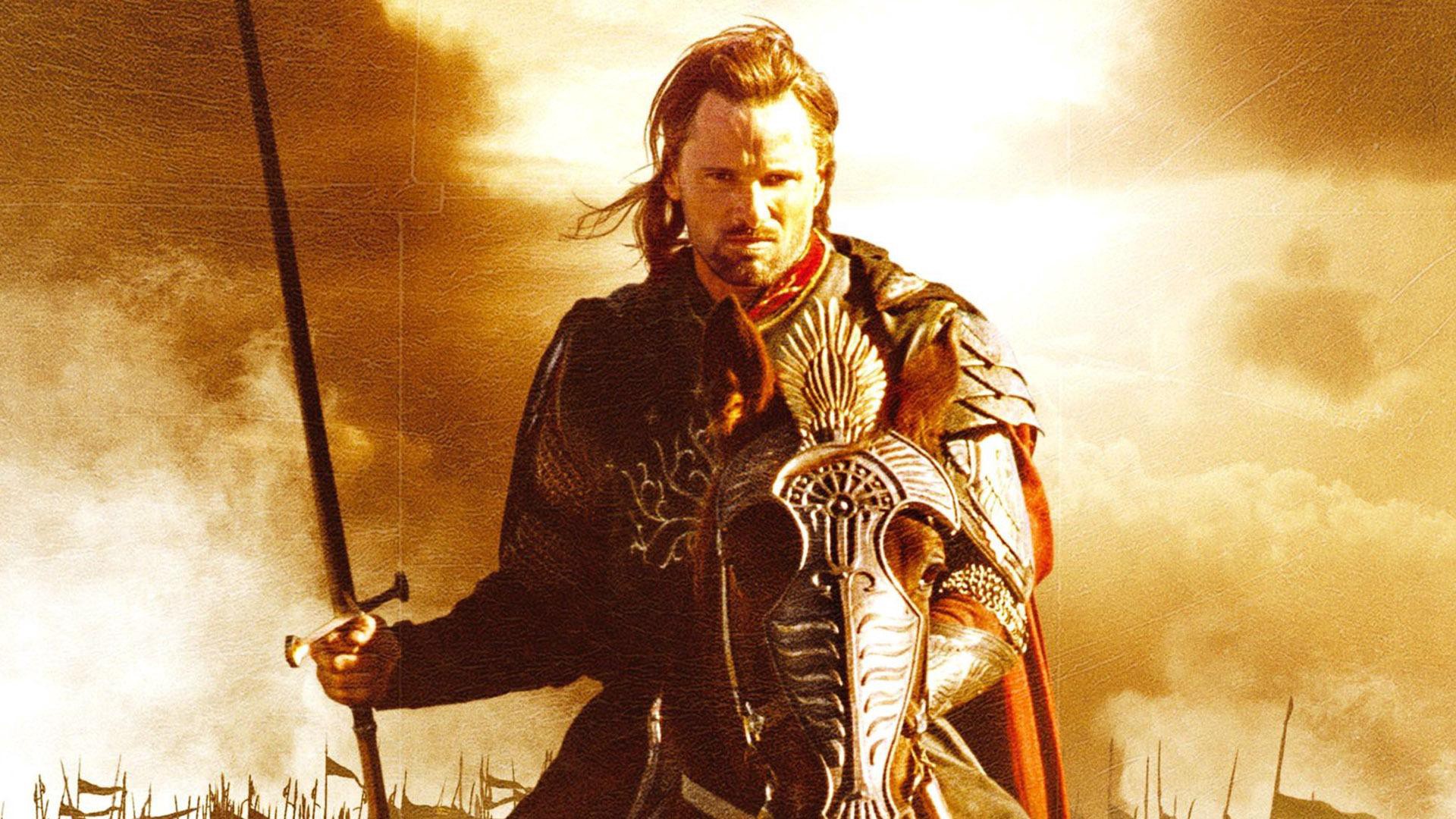In King, Warrior, Magician, Lover ? Robert Moore and Douglas Gillette propose that masculinity is made up of four components, each found as the balance between two ?energies?. Since the book was published in 1990 it has had a large impact on masculinity in culture and led to a resurgence of men?s groups. These groups often participate in retreats or other rituals to remind them of their masculinity.

Let?s take a moment to examine each of the ?energies?, and the bi-polar shadows which accompany them. In this model, the King in his fullness has balanced the tyrant and the weakling, but he has also mastered the Warrior, Magician, and Lover aspects of his masculinity.
The Lover: This archetype appears to be about sex alone, but it is really about emotion. The range and capability to feel deeply, to experience joy and pain. It reminds me of Ralph Waldo Emerson, who wrote, ?Never lose an opportunity of seeing anything beautiful, for beauty is God?s handwriting.? It seems many men are lacking in this trait, especially in a culture that encourages pushing down emotions. In comedian Bill Burr?s bit on ?Why Men Aren?t Sensitive? he points out how men attack each other when one is acting ?like a girl?; and it is funny because it?s true. My favorite King who is confident enough to express emotion deeply, and publicly is Aragorn, from Lord of the Rings.
When Gandalf and Aragorn are discussing Frodo?s quest, Gandalf asks, ?Do we know that [Frodo is alive]??. Aragorn replies, ?What does your heart tell you??. To which Gandalf smiles and says, ?that Frodo is alive?. This moment is unique to Aragorn as a future King and leader, you cannot imagine Robert Baratheon or Commodus replying in this way.
When Aragorn first encounters the hobbits of the Shire they are hesitant to accept him as a companion until they read Gandalf?s letter revealing Strider?s identity as Aragorn, and a friend. They ask him why he did not mention his connection to Gandalf earlier, to which he replies ?I hoped you would take me for my own sake. A hunted man sometimes wearies of distrust and longs for friendship.? The vulnerability of this interaction shows that Aragorn has mastered the Lover archetype, and is closer to being the archetypal King.
Empathy, an increasingly rare trait, is depicted in the lover. The lover?s energy is boundless and is balanced out by the structure and discipline of the Magician and Warrior.
 Leonardo DiCaprio as Jay Gatsby
Leonardo DiCaprio as Jay Gatsby
The lover archetype has two shadows, the addicted lover and the impotent lover. The addicted lover is eternally restless, constantly searching for something or someone to fall in love with, and when the love affair is over is down in the dumps. Jay Gatsby is a great example of the addicted lover, he is addicted to the idea of Daisy, not in love with Daisy the human being.
The impotent lover sees everything as gray and has no enthusiasm for life. He can be a man who disciplines himself too much or tries too hard to be perfect. This can often occur in overly religious men, whose zeal has gotten in the way of passion for life.
The way to balance the two is to cultivate the virtue of moderation and to be fully present in life. The Jedi have mastered being fully present, remember Qui-Gon-Jinn?s admonishment to Obi-Wan Kenobi ,?Don’t center on your anxieties. Keep your concentration here and now, where it belongs?. While the Jedi have perfected this aspect, they have failed in other categories of the ?Lover? energy, which I will address in another article.
The Warrior: This archetype is often received negatively because many people including women and children have suffered due to the shadow form of the warrior. While these criticisms are accurate it is important to remember that the warrior, when balanced thinks, ?I am responsible for what happens here? and ?I must do what I can to make this world better for myself and others.? The warrior trains and perfects his character, he is never dramatic for the sake of drama, and never acts to show his power. The archetype of the warrior is innate to men, the question is how will it be used?
The warrior is not specific to acts of violence, acts of non-violence can equally show one imposing their will on the world around them, the sign of a warrior. Finally, and most importantly, the warrior fights for something more than themselves, they fight for a nation or a cause, where each deed is done as if it were their last. The shadow forms of the warrior can be the most troubling aspects of masculinity when the sadist or the masochist is employed.
The sadist becomes a man?s permanent state when he stays emotionally detached indefinitely. It can be an advantage to detach yourself from emotions when making business decisions, or when acting in a crisis, but if you cannot return to emotionally stability the sadist energy has infiltrated the psyche.
The masochist is represented by someone who enjoys being the martyr. He feels he has no power and is a push-over. The man under this influence may take a certain amount of abuse before quickly flipping to the sadist pole. Remember the bi-polar shadow energies feed off each other.
The Magician: All knowledge that takes special training to acquire is the province of the Magician energy. The magician commits to lifetime learning and has an innate intellectual curiosity. When mastered the magician energy has deconstructed the ego and led to thoughtfulness and insight.The magician keeps the other archetypes in balance and is the steward of the psyche.
The Magician archetype is about ?claiming our capacity as co-creators of the universe?. There are multiple methods of participating in creation, there are the physical inventions which can be developed and the transformation of the psyche. ?Ours is, we believe, the age of the magician because it is a technological age? It is an age of the magician at least in his materialistic concern with understanding and having power over nature. But in terms of nonmaterialistic, psychological, or spiritual initiatory process, the magician energy seems to be in short supply? (Moore and Gillette).
For example many public intellectuals have commented that our tech companies, Facebook, Twitter, Youtube, need fewer programmers and more philosophers. Students are flooding into the STEM fields at increasing rates, and leaving philosophers and teachers lacking. This leads to the creation of products without full consideration of the fallout. Thus we create an entire generation of kids addicted to their cell-phones through no fault of their own or social media platforms that are more focused on new features than data security.
This imbalance comes from a lack of initiation rituals. And a lack of sacred space. Sacred space does not require a belief in a specific religion, it is more like the force in Star Wars. A belief in a regenerative power for personal and social regeneration.
The shadow forms of the magician are the manipulator and the innocent. The manipulator is a huckster promising secrets behind a paywall. The innocent shadow is naive, it wants all the power and wealth but has no interest in working for it. This is the person who decides on a band name but never practices.
The manipulator is the mature shadow of the trickster, think of the Joker, ?This is the energy form that seeks the fall of great men, that delights in the destruction of a man of importance. But the trickster does not want to replace the man that has fallen. He does not want to take on the man?s responsibilities. In fact, he doesn’t want any responsibilities. He wants to do just enough to wreck things for others? (Moore and Gillette).
The Lack of magicians in our society is causing an imbalance, think of the military, their ?pseudo-initiations? create warriors, but they often fail to bring the warrior home, not physically but mentally.
The King: A Renaissance Man ? warrior, magician, and lover. He is steadfast, decisive, and wise. He provides protection and order. The borders of his Kingdom separate the order from the chaos. He is a temporary steward of the King energy, and recognizes that one day his time will be over, and new life will replace him as king. When the Lich King speaks to his son Arthas in the Warcraft Universe he says, ?The truest victory my son is in stirring the hearts of your people. I tell you this, for when my days have come to an end, you shall be King.? He accepts his role as temporary steward and prepares to pass the torch on to his son. The true King relies on the voice that comes from within; he minimizes punishment and maximizes praise.
The tyrant shadow is narcissistic, drags others down, and tries to maintain an illusion of absolute power. The tyrant fears new life rather than revering it, he fears that every new subject could be the one that will replace him. Think of Herod in the Bible, or Commodus in Gladiator, they will kill babies in order to defend their Kingship. He is paranoid because of his passive ?weakling? energy and attempts to conceal it with a show of strength. The shadow energies work closely together, for the tyrant is concealing a weakness. Macbeth displays this paranoia, and it leads him to madness.

In Literature King Elessar (Aragorn), and King Arthur are the closest I see to mastery of the male archetype.
Next week I will be writing about Aragorn?s journey to become King Elessar, and the ways he embodies the perfect archetypal King.
We can learn from Moore and Gillette and begin living out the archetype of the King in our daily lives, and in our writing.
Please follow, and let me know, who do you think is the perfect archetypal King?
Josh
December 2018


